Mt. Koya (Koyasan) guide
Temperature
The temperature in Koyasan is 6.0 degrees Celsius lower than that in Osaka,
Please dress as warmly as possible.
Train Discount Ticket
Nankai train discount ticket
Koyasan World Heritage Digital Ticket 4,500 yen → 3,150 yen Nankai railway
If you want to purchase the digital ticket, please purchase the tickets by the day before boarding.
The Koyasan World Heritage discount ticket 4,500 yen → 3,450 yen
You can purchase at the Namuba station ticket office.
Mt. Koya (Koyasan)
Mt. Koya(koyasan) is a center of Buddhist study and practice.
It was founded about 1200 years ago by the Buddhist monk Kukai (Kobo Daishi)
as a place for Shingon Buddhist training.
![]()
![]()
Great Gate Daimon is the main gate of the holy Koya mountain in Wakayama
prefecture.
Originally a torii gate in Tsuzura valley used to be the main entrance
when Kobo Daishi founded his monastery.
The ruins of that torii gate, called Ancient Daimon(Kodaimon), can be found 400-500m down from the present site.
Daimon gate was constructed in 1140, but it
has been destroyed several times. The present gate was rebuilt in 1705 and is
25.1m high.
On both side of the gate, statues of
protector deities watch over the entrance of the Koyasan.
On the central pillars of the gate, there
are couplet plates.
The source of the couplet words is the
sentence written by Jogaku, the archbishop of the Toji temple in the 11th
century.
It means that although Kobodaishi remains in eternal meditation at Okunoin, he appears at the place of close connection everyday and pray for the
liberation of all beings.
On the clear days, visitors can glimpse
distant Awaji island and the Inland sea in the west.
The view of the sunset here is spectacular
and selected one of the best 100 in Japan.
It is registered as a National Important
Cultural Asset.
The gate is illuminated at night.
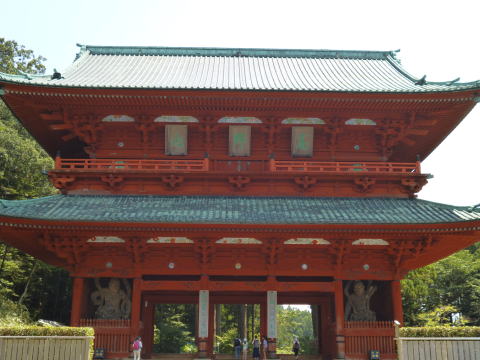
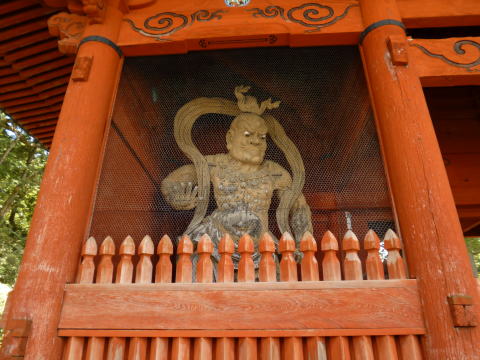
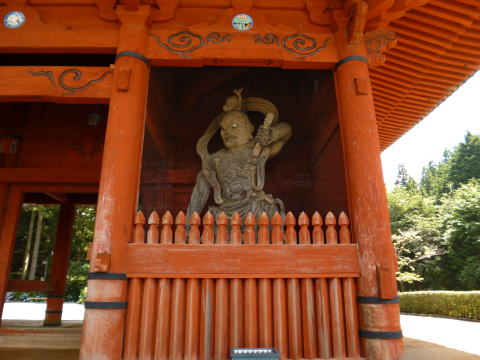
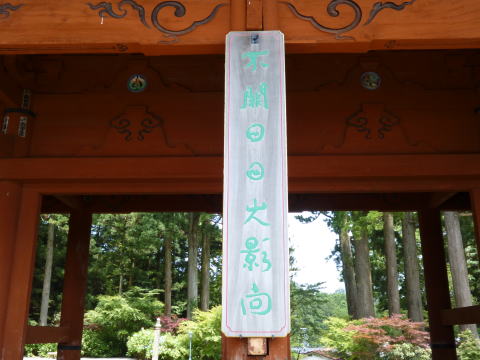
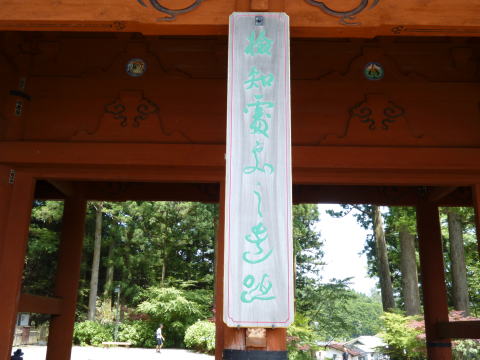
![]()
![]()
Okunoin and Danjo Garan are considered the most sacred areas of Koyasan.
The name Garan is derived from Sanskrit,
and means a quiet and secluded place where Buddhist monks may train.
The Garan is where Kobo Daishi actually
began construction himself in the early years of Koyasan’s history.
In 819 the guards, Niutsuhime and
Karibamyojin were enshrined here.
In addition the construction of Great
Stupa, the golden hall and many other buildings had begun during Kobo Daish’s lifetime.
The path leading to the Danjo Garan from
the east is illuminated at night, and in autumn the maple leaves here are
beautiful.

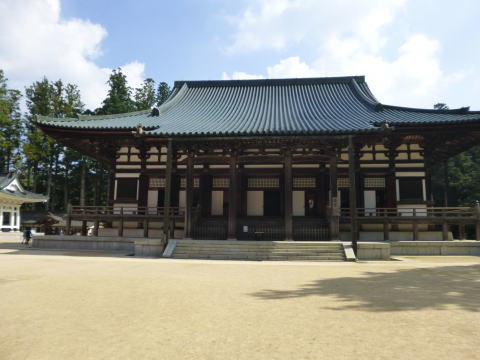
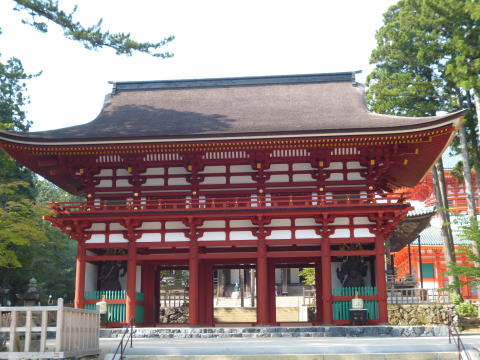
Konpon Daito (Great Fundamental Pagoda) ![]()
The Konpon Daito is the tallest building in Koyasan.
After Kobo Daishi Kukai was granted the use of Koyasan by Emperor Saga in 816, he decided to build the first monastic complex entirely dedicated to the teaching and practice of Esoteric Buddhism.
He planned to construct two large two-storied pagodas diagonally behind
the Kondo in the eastern and western directions.
Plans called for the Konpon Daito to be about 48.5m high, and because of its great size it was finally completed around 876, over 40 years after Kobo Daishi entered into eternal meditation.
In later centuries the Konpon Daito was destroyed in fires caused by lightning
strikes five times, and rebuilt each time.
After the great fire of 1843, only the foundation stones remained. The existing building was rebuilt in 1937.
Architecturally, the Konpon Daito is classified as an early form of the
two-storied pagoda.
The body of the pagoda is circular, with a square lower storey with and
attached pent roof and walls.
The majestic Konpon Daito is today exactly as it was when it was first
constructed, and is known as a symbol of Koyasan (Mt. Koya).
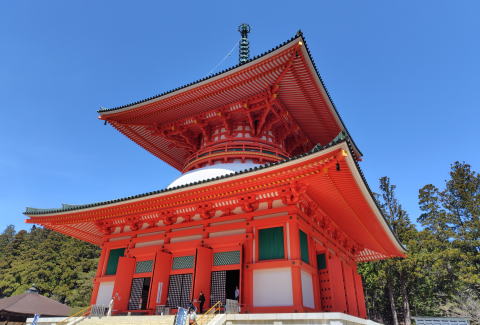
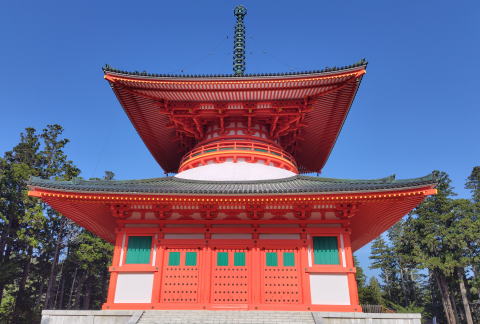

"Shinbutsu-shūgō" refers to the syncretism of Buddhism and Shinto
in Japan.
Shinbutsu-shūgō (Syncretism of Kami and
Buddhas)
In Japan, there is a unique blend of
Buddhism and Shinto called "Shinbutsu-shūgō." This term means the
combination or amalgamation of Shinto and Buddhist beliefs and practices.
Shinto, the indigenous spirituality of
Japan, focuses on the worship of kami (spirits or gods) associated with nature
and ancestors. Buddhism, which came to Japan from China and Korea in the 6th
century, brought new teachings, rituals, and deities.
Over time, the two religions began to
influence each other. Temples and shrines were built together, and many people
started to worship both kami and Buddhas. Shinto gods were sometimes seen as
manifestations of Buddhist deities and vice versa. This fusion created a unique
religious landscape in Japan, where both traditions coexist and are often
practiced together.
This blending continued until the Meiji
period (1868-1912), when the government sought to separate Shinto and Buddhism
to promote Shinto as the state religion. Despite this separation, the influence
of Shinbutsu-shūgō remains evident in Japanese culture and religious practices
today.
The differences between Buddhism and Esoteric Buddhism (Mikkyo) :
Buddhism, founded by Siddhartha Gautama (the Buddha) in the 5th century BCE in India, focuses on the following core teachings and practices:
Esoteric Buddhism, particularly prominent in the Shingon and Tendai sects in Japan, incorporates more secretive and ritualistic elements. Key aspects include:
Transmission of Teachings:
Rituals and Practices:
Approach to Enlightenment:
Concept of Enlightenment:
In summary, while both Buddhism and Esoteric Buddhism share the same foundational
goals of achieving enlightenment and liberation from suffering, Esoteric
Buddhism incorporates more elaborate rituals, secretive teachings, and
a focus on achieving enlightenment in the present life through specific,
symbolic practices.
The Taizokai Mandala and the Kongokai Mandala of Shingon Buddhism:
The Taizokai Mandala, also known as the Womb World Mandala, represents the physical world and the cosmos from the perspective of compassion and enlightenment. It is associated with the principle of "Dainichi Nyorai" (Mahavairocana Buddha), who embodies the universal truth. This mandala is divided into multiple sections, each containing various deities and bodhisattvas, symbolizing different aspects of spiritual wisdom and compassion. The central figure is Dainichi Nyorai, surrounded by other enlightened beings, illustrating the interconnectedness of all things and the potential for all beings to achieve enlightenment.
The Kongokai Mandala, also known as the Diamond World Mandala, represents the spiritual and indestructible nature of enlightenment. It emphasizes the power and wisdom needed to achieve enlightenment. The central figure in this mandala is also Dainichi Nyorai, but in this context, he represents the unchanging, eternal truth. The mandala is arranged in a highly symmetrical and geometric pattern, symbolizing the clarity and precision of the enlightened mind. The deities in this mandala are associated with different forms of wisdom and power, reflecting the path of rigorous practice and insight.
Both mandalas are used in Shingon Buddhism to aid meditation and visualization practices. Practitioners focus on the detailed images and symbolism within the mandalas to deepen their understanding of Buddhist teachings and to progress on their path to enlightenment. These mandalas serve as maps of the spiritual universe, guiding practitioners through different stages of spiritual development.
In summary:
Both mandalas complement each other, offering a comprehensive framework for understanding and achieving enlightenment in Shingon Buddhism.
![]()
![]()
Just as Kobo Daishi was departing from Tang China to return to Japan in
806,
he is said to have thrown a three-pointed vajra, a Shingon Buddhist ritual
item, toward Japan from the port of Mingzhou
with the wish of finding a place appropriate for establishing Shingon Buddism
in Japan.
After returning to Japan he serched for the study center of the Shingon Buddhism.
He came to Koyasan and found the three pointed vajra lodged in the pine
tree.
Since then, the pine tree has been called the Sanko no Matsu, or the three-pointed
Vajra Pine Tree,
and is popularly connected with faith in Kobo Daishi.
Pine needles usually come in clusters ranging from two to five needles,
the needles of Sanko no Matsu however, are in clusters of three, like the
three-pointed vajra it is named after.
Visitors today treat needles of Sanko no Matsu as talismans and keep them
as lucky charms.
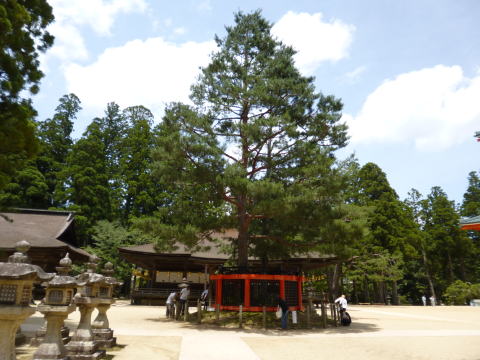
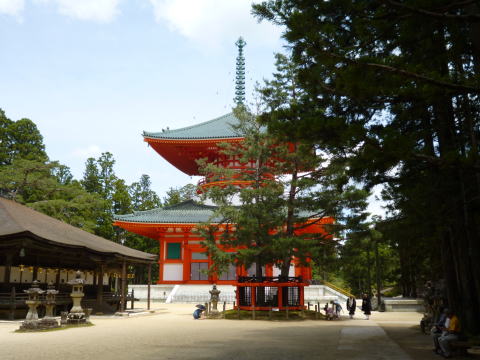
![]()
![]()
Koyasan Reihokan Museum is located at Koya
Town in Wakayama Prefecture.
Koyasan is a treasure trove of Buddhist
art, with statues, ritual implements, scriptures, and other cultural assets.
Reihokan was built in 1921 to house and display many of the valuable artworks.
The museum holds National Treasures, Important Cultural Assets or Prefectural
Designated Cultural Assets, totaling more than 28,000 items.
Many of the most outstanding examples of
Buddhist art in Japan are found here.
The museum building itself is modeled after
the Phoenix hall of Byodoin Temple in Uji Kyoto, and is a registered Tangible
Cultural Property.
From Koyasan station of the Nankai Koya line, it takes about 10 minutes
to Reihokanmae bus stop.
In front of the museum, there is a free parking spot .
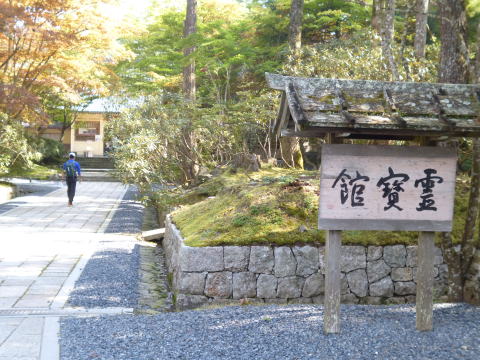

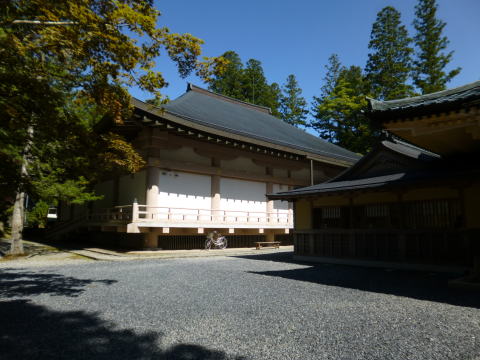
![]()
Kongobuji is located at Koyasan in Wakayama prefecture.
Kongobuji is the administrative head temple of Koyasan Shingon Buddhism.
The temple was founded in 816 by Kukai.
Originally the entire area of Koyasan was known as Kogobuji and there was
no specific building by that name.
In 1593, Hideyoshi TOYOTOMI built Seiganji temple and Mokujiki OGO built
Kozanji temple next to Seiganji temple.
The building now called Kongobuji was combined in 1869 from those two temples.
The temple contains beautiful screen paintings and Japan's largest rock
garden, the Banryutei.
From Koyasan station of the Nankai Koya line, it takes about 10 minutes
to Konobuji bus stop.
In front of the temple, there is a free parking spot.

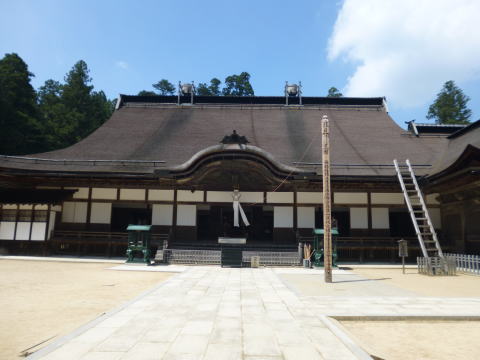

Koyasan Daishi Kyokai ![]()
Koyasan Daishi Kyokai is located at Koya town in Wakayama prefecture.
This is the central site for the promotion of Koyasan Shingon Buddhism,
hymns, and Shingon dance.
Various workshops and study sessions are also held here.
Daikodo (auditorium) was constructed in 1925 the 1,100 year anniversary
of Mount Koya's founding.
Enshirined therein is an image of Kobo Daishi (Kukai), flankled by images
of Ragaraja and Acala.
The Daikodo has a sutra hall at the back inwhich you can learn the ten
precepts (Buddhist ways of thinking that you can use in everyday life)
from a high monk.
Shingon Buddhist Culture Center
Completed in 1982 as part of the 1150th memorial celebration, this building serves as the center for the Koyasan Shingon sect's religious education and training wihtin the tradition of faith in Kobo Daishi.
A modern two-floor, reinforced concrete structure, it is fully equipped
with moderan facilities and connected to the Daikodo (aduditorium) by corridor.
Utilized as a center for various Buddist cultural activites, it accomodates
up to 400 people, among which are usually clerical instructors, temple
family members as well as parishioners.
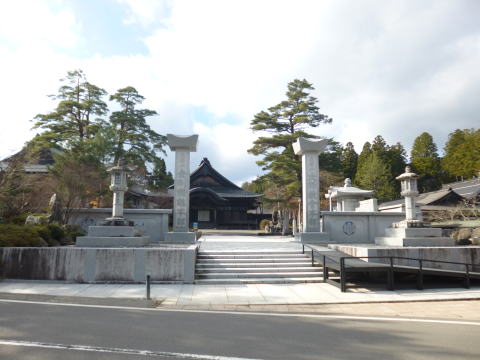
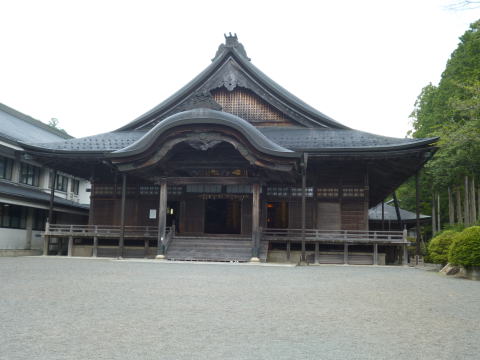
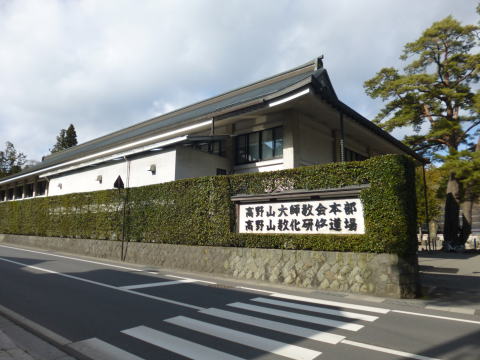
Experience (Practice)
Sutras
In this practice, the teachings of the Buddha are received directly in
a sermon from a high monk.
This is one of the most emblematic traditions of Mount Koya and is availble for participation year-round.
The Ten Precepts descrived therein were popularized through the ages as
an accessible form of teaching for lay people.
They describe codes of conduct that now, more than ever, are relevant to
modern society.
If people everywhere lend an ear to these precepts, we can achieve a better,
richer society.
They descrive proper conduct and poise of mind.
Start time 9:00 10:00 11:00 13:00 14:00 15:00 16:00
Lengh of prctice about 30 minutes
Entrance donation 1,000 yen per person
Sutra
Copying, Offering sutra and the Heart Sutra
(写経、納経と般若心経)
1 Sutra Copying (写経)
1-1 Background
of Shakyo (Sutra Copying)
Shakyo, or the practice of copying sutras, is a traditional Buddhist activity
that has been carried out for centuries in Japan. It involves writing sacred
Buddhist scriptures, such as the Heart Sutra (Hannya Shingyo), with mindfulness
and devotion.
Mount Koya, a sacred site and the center of Shingon Buddhism, is one of the most renowned places for shakyo experiences.
Temples across Japan also offer this practice, welcoming visitors from all backgrounds.
1-2 Significance
of Shakyo
Shakyo is much more than a calligraphic
exercise; it is considered a form of meditation and spiritual practice. Each
character is written with care and intention, allowing practitioners to focus
their minds and cultivate a sense of calm and inner peace. It is also an act of
devotion and reverence toward Buddhist teachings, as well as an offering to the
Buddhas and Bodhisattvas.
2 Offering Sutra (納経)
2-1 What is Offering sutra (Nōkyō) ?
Nōkyō refers to the act of offering a sutra, such as a completed sutra
copied during a shakyo (sutra copying) experience, to a temple. After participants
carefully write the text using brush and ink, they typically present the
finished sutra to the temple as an offering.
2-2 The Significance of Nōkyō
2-2 2-2-1
A Gesture of Devotion:
2-2-2 Prayer and Merit:
2-2-3 Symbol of Letting Go:
2-2-4 Connection with the Temple and Tradition:
2-3 A Spiritual Cycle
The process of writing, dedicating, and
offering the sutra reflects a cycle of mindfulness, effort, and release. For
many, it is a deeply meaningful way to engage with Buddhism, even if they are
new to the practice.
Whether one participates for religious reasons or as a personal spiritual
experience, nōkyō is a way to leave a part of oneself in a sacred space
while seeking peace and blessings.
3 The Heart Sutra (般若心経)
3-1 What is the Heart Sutra?
The Heart Sutra (Hannya Shingyo in Japanese) is one of the most famous
and concise Buddhist scriptures. It is highly regarded for summarizing
the essence of Buddhist philosophy in just a few lines. Though brief, it
carries profound teachings about the nature of reality and the path to
enlightenment.
3-2 The Core Message of the Heart Sutra
3-2 3-2-1
Emptiness (Shunyata):
3-2-2 Overcoming Suffering:
3-2-3 Wisdom (Prajna):
3-3 Famous Line: “Form is emptiness,
emptiness is form”
One of the most famous phrases from the Heart Sutra is:
“Form is emptiness, emptiness is form.”
This line highlights the idea that the material world we experience (form) is
not separate from emptiness but is instead part of it. It encourages us to see
beyond appearances and recognize the interconnected nature of reality.
3-4 Why is the Heart Sutra Important?
The Heart Sutra is not just a philosophical text; it is also a guide for
meditation and practice. Reciting or writing it helps practitioners focus
their minds, reflect on the teachings, and strive for greater understanding
of themselves and the world.
This sutra is often chosen for shakyo (sutra copying) because of its profound
meaning and its manageable length. Through writing or chanting the Heart
Sutra, even visitors who are new to Buddhism can experience its calming
and insightful teachings firsthand.
![]()
![]()
The Tokugawa Mausoleum is located 0.5km to the north-northeast of the Garan
area.
This mausoleum for the Tokugawa family was
built in 1643 by Iemitsu Tokugawa, the third Tokugawa shogun, who devoted twenty
years to its construction.
The two mausoleums are separated with
Sukibei or a lattice-windowed wall.
To the right is the mausoleum of the first
Tokugawa shogun, Ieyasu and on the left is the mausoleum of Hidetada, the
second shogun.
The outside is built of unfinished wood and the inside is decorated in
gold and silver leaf, reminiscent of the Toshogu Shrine in Nikko, which
is one component of the World Heritage site, “Temples and Shrines of Nikko”.
From Koyasan station of the Nankai Koya line, it takes about 10 minutes
to Namikirifudo-mae bus stop.
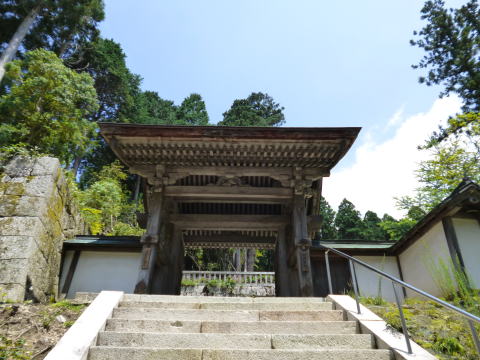
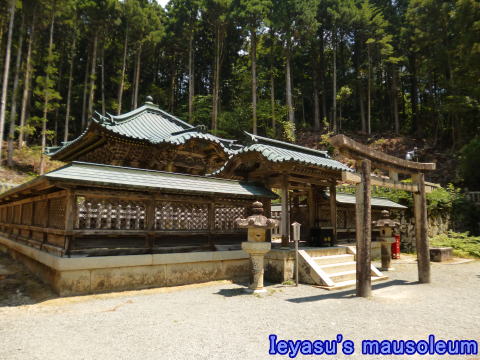
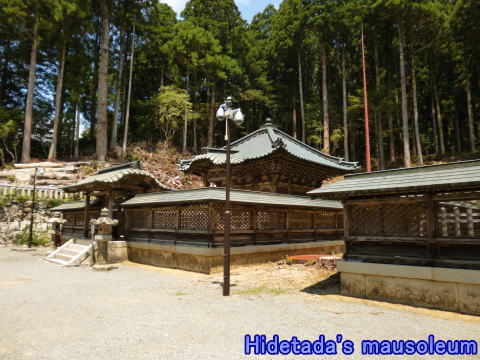
Shojoshin-in ![]()
Shojoshin-in is a special head temple of the Shingon sect, located on the
west side of Ichinohashi Bridge at the entrance to Okunoin, Mount Koya,
Wakayama Prefecture.
The principal image is a statue of Kobo Daishi, which is said to have been carved by Kukai (Kobo Daishi) himself on March 20, 835, the day before his death, with the three characters "Miunkan" written on the back of the statue.
From this, it is called "Twenty Days of the Great Master" and
is currently a secret Buddha.
Every year, on the principal image's festival day (currently April 20),
it is opened to the public and a grand memorial service is held.
Founded by Kukai during the Tencho era (824-833), it was originally called
Kitabo, but was renamed Shojoshin-in by imperial decree, and later, Taira
no Kiyomori's son Munemori rebuilt the temple.
The Tale of the Heike, Volume 10, states that Takiguchi Nyudo, who had
retired to Saga Ojo-in Temple as a monk, climbed Mount Koya to break his
attachment to the flute and lived in the temple.
During the Warring States period(16th century), the temple became a place
of prayer for Uesugi Kenshin, and houses many letters written by Kenshin
and Uesugi Kagekatsu. The temple also manages the Uesugi Kenshin Mausoleum
(a nationally designated Important Cultural Property) in Okunoin semetary.
Satake Yoshishige also performed a memorial service here, and letters from
Satake Yoshiaki and Yoshinori are also in the collection.
Within the grounds is a famous umbrella cherry tree, where Toyotomi Hideyoshi is said to have held a cherry blossom viewing.
Goma prayers are held every day in the goma hall.
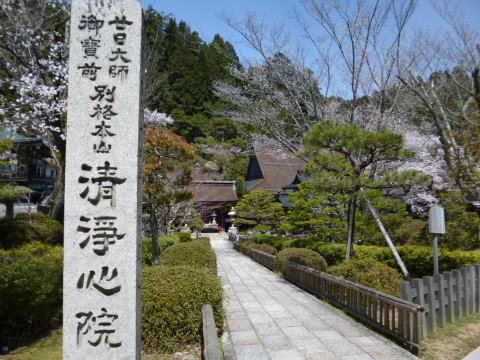
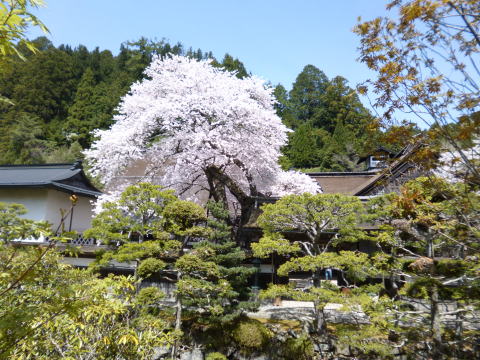

Goma Fire Ritual at Koyasan Temples
The Goma Fire Ritual is a sacred ceremony in Japanese esoteric Buddhism, especially practiced in temples at Koyasan.
It is a powerful prayer ritual aimed at purification, protection, and the
fulfillment of wishes.
During the ceremony, wooden sticks called Gomaki (護摩木) are used to symbolize people's desires, prayers,
or problems.
These wooden sticks are written on by participants with their wishes or
concerns.
The temple's priest then places the Gomaki into the sacred fire, which
is believed to transform these wishes into spiritual energy that reaches
the deities. The fire represents the wisdom of the Buddha, burning away
negative karma and obstacles, and purifying the mind and body.
The Goma ritual is accompanied by chanting and the rhythmic sound of drums, creating a deeply spiritual atmosphere.
It’s a unique and moving experience, open to anyone seeking blessings for themselves or their loved ones.
Many temples in Koyasan offer the Goma ritual, and visitors can participate
by offering their own Gomaki for the ceremony.
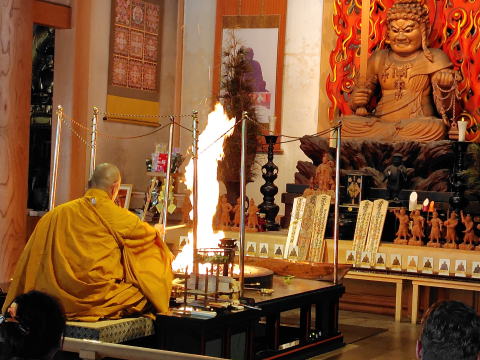
![]()
Okunoin is a cemetery and sacred area that extends about 2km from the Ichinohashi bridge to Kobo Daishi's mausoleum.
The path is lined on both sides by hundreds of centuries-old towering cedar
trees.
Among the trees are over 200,000 gravestones and memorial pagodas for people
ranging from important figures to commoners.
In the prayer for the Manto-Mange-e ceremony in 832, Kobo Daishi wrote, "When the universe,
all living beings, and nirvana are exhausted, my wish then be fulfilled."
In other words, he made a great vow:
"As long as all living beings in the universe try to attain enlightenment,
as long as they try to become Buddas, as long as people keep seeking nirvana,
I will not finish my prayers.
There is writen stone sign of his vow on the left side of the path.
Every year on August 13th, Candle Festival (Rosoku Matsuri) is held on
the path.
100,000 candles are lit along the path in the precincts of Okunoin from
the Ichinohashi bridge to the Torodo (Lantern Hall).
From 8:00pm, a Buddhist memorial ceremony is held at the Torodo.
The best way to approach Okunoin is to take the bus from Koyasan station
to Ichinohashimaebus stop.
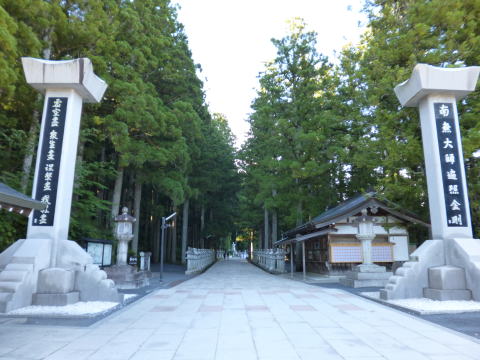
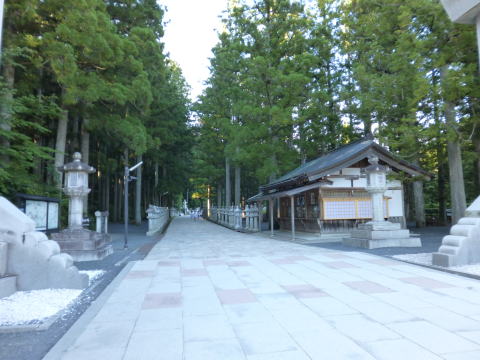
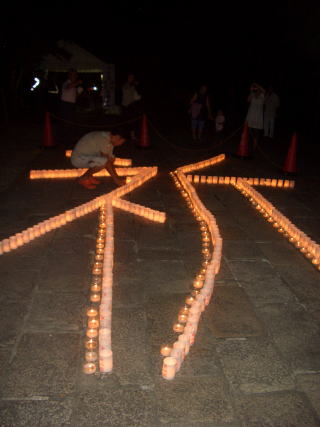
The Okunoin Gokusho (the offering hall) ![]()
![]()
The Okunoin Gokusho (the offering hall) is located in Mount Koya in Wakayama
Prefecture.
It is said to have started as a small hermitage built to serve the mausoleum
of Kukai (Kobo Daishi).
Even today, daily offerings to Kobo Daishi are made at the Gokusho and
are carried to the tomb by priests twice a day, at 6am and 10:30am.
To the north of the Gokusho is the Ajimi Jizo.
It is said that these Jizo were originally Aiman and Aigo, two disciples who took care of Kobo Daishi's meals, and were enshrined as Mikuriya Myojin near the Gobyo Bridge.
The food for Kobo Daishi is prepared at the offering hall and placed in
a chest, where it is offered to the Jizo statue by priests called Yuina
and Gyoboushi, and then carried to the Lantern Hall in front of the mausoleum.
This is based on the "Kobo Daishi faith," which believes that
Kukai is still in eternal meditation at the mausoleum, watching over future
generations.
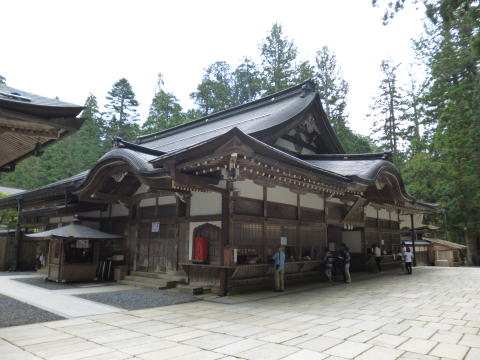
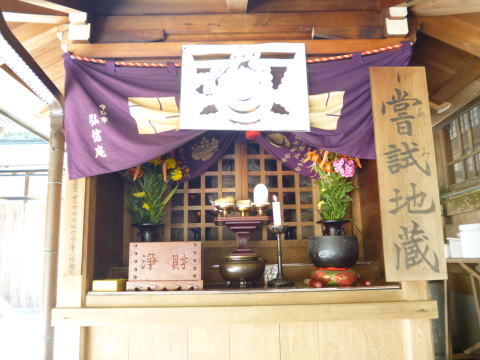
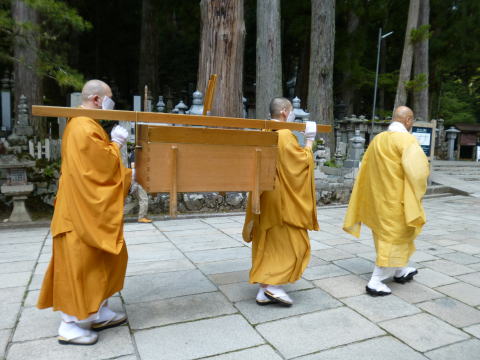
Eko-in temple ![]()
Eko-in temple is a Shingon Buddhist temple located in Renge-dani, Mount
Koya, Wakayama Prefecture.
The principal image is Amida Buddha.
The temple is said to have been founded
when Kobo Daishi built a five-foot pagoda here and gave a lecture on Daikyo-o Sutra.
It is said to have been founded by Dosho
Sozu, one of Kobo Daishi's ten greatest disciples.
It was restored by Shonin Ajari, who became
an inspector (Kengyo) in 1139.
It was second restored by Toji Ajari
Ryocho, who offered a lantern from Toji Temple in the Enkyo era (1308) to
restore the local Hodoin-dani valley.
During the Sengoku period, the temple was a patron of the Shimazu clan,
and in 1563, the memorial stone of Shimazu Yoshitora was enshrined at the
temple.
Later, Yoshihiro erected a memorial stone for his eldest brother, Yoshihisa,
in Okunoin, and also built a memorial stone for the allies and enemies
of the Korean battle out of Ryukyu stone in Okunoin.
It is located near Ichinohashi Bridge at the entrance to Okunoin, and the "Koyasan Okunoin Night Tour" (19:15 - 20:30) starts from this temple every night.
Take a bus from Koyasan Station on the
Nankai Koya Line and get off at Karikayado-mae stop.
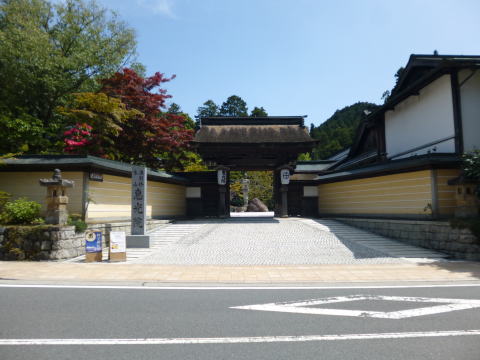

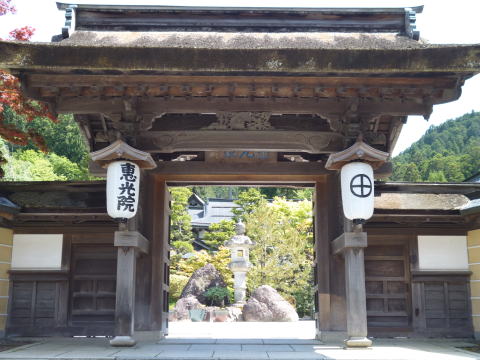
Model courses of Mt.Koya (Koyasan) tour
1 Mt.Koya sacred 4hr Private Tour with Guide
Koyasan station (or lodging temple)
Danjo Garan Temple Complex
Kongobuji Temple
Okunoin (Cemetery)
2 Mt.Koya sacred 6hr Private Tour with Guide
Koyasan station (or lodging temple)
Danjo Garan Temple Complex
Koyasan Reihokan Museum
Koyasan Daishi Kyokai
Kongobuji Temple
Tokugawa's Mausoleum
Okunoin (Cemetery)
3 Mt.Koya sacred Full-Day Private Tour (Osaka departure) with Guide
Hotel in Osaka
Danjo Garan Temple Complex
Kongobuji Temple
Okunoin (Cemetery)
Hotel or station in Osaka
Comments of the tour guest
Our tour with Naka was flawless from the start when he met us at the hotel
and guided us through the several modes of transport to reach Koyasan.
The sheer beauty of the site was enhanced by Naka’s deep knowledge of its history and cultural significance.
In addition to the highlights, Naka pointed out many small details that
we would have completely missed had we done this on our own.
This was a truly memorable experience.
Shojin Ryori (精進料理)
Buddhist vegetarian cuisine (the Shojin Ryori )
originates in China, and adapted to Japan by monks throughout the years.
In accordance with Buddhist teachings, the vegetarian
meal is made by the delicate enhancement of a natural taste, the use of limited
ingredients as well as the nonuse of meat.
It is based on the concept of five flavors, five
cooking methods and five colors.
A meal should include a grilled dish, a deep-fried
dish, a pickled dish, a tofu dish and a soup dish.
Sesame Tofu ( Goma dofu ) is Koyasan’s highly nutritious foods containing
precious protein, and is served up very often at the restaurants and Shukubo
temple.
1 Major English Web Sites
Kongobuji
A Guide to Koyasan
Koya Tourism Association
Okunoin Cemetery Night Tour Night tour information
Koyasan Cross-cultural Communication Network(KCCN)
2 Activities in Koyasan
Powdered Green Tea Experience
3 Access Information by train and bus
Koyasan Access Map by Train
Train and Bus timetable from Osaka to Koyasan (weekday)
Train and Bus timetable from Osaka to Koyasan (Holiday)
Bus and Train timetable from Koyasan to Osaka (weekday)
Bus and Train timetable from Koyasan to Osaka (Holiday)
Bus service to Kumano
Access to Kyoto Shinkansen Kumanohongu Nara
Nankai Railway
Koyasan World Heritage Disital Ticket
4 Access information by car
Route from Osaka to Koyasan
5 Other Web Sites
Koyasan Restaurant Map for Lunch for Dinner
Hanabishi vegitarian restaurant
Tera cafe Seikei-in
Tempu Terrace
Komi cafe
The Official Wakayama Travel Guide
BBC travel Wakayama prefecture
Kansai scene
Japan the Official Guide
Kansai finder
Deep Experience
Kisho-horai
Japan Visitor Hotline 050-3816-2787
michi samurai and Japanese cultural experience in Osaka
TOP PAGE 観光カレンダー
TOP PAGE 观光最佳时期